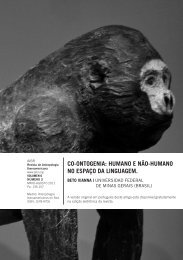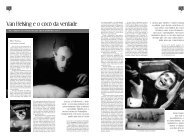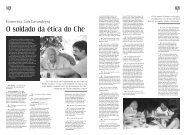Merleau-Ponty, 1964. Eye and mind. - Biolinguagem
Merleau-Ponty, 1964. Eye and mind. - Biolinguagem
Merleau-Ponty, 1964. Eye and mind. - Biolinguagem
- No tags were found...
Create successful ePaper yourself
Turn your PDF publications into a flip-book with our unique Google optimized e-Paper software.
which would still imply that the body itself is without an inside <strong>and</strong> without a "self." A<br />
human body is present when, between the see-er <strong>and</strong> the visible, between touching <strong>and</strong><br />
touched, between one eye <strong>and</strong> the other, between h<strong>and</strong> <strong>and</strong> h<strong>and</strong> a kind of crossover<br />
occurs, when the spark of the sensing/sensible is lit, when the fire starts to burn that will<br />
not cease until some accident befalls the body, undoing what no accident would have<br />
sufficed to do…<br />
Once this strange system of exchanges is given, we find before us all the problems of<br />
painting. These problems illustrate the enigma of the body, which enigma in turn<br />
legitimates them. Since things <strong>and</strong> my body are made of the same stuff, vision must<br />
somehow come about in them; or yet again, their manifest visibility must be repeated in<br />
the body by a secret visibility. "Nature is on the inside," says Cézanne. Quality, light,<br />
color, depth, which are there before us, are there only because they awaken an echo in<br />
our bodies <strong>and</strong> because the body welcomes them.<br />
Things have an internal equivalent in me; they arouse in me a carnal formula of their<br />
presence. Why shouldn't these correspondences in turn give rise to some tracing<br />
rendered visible again, in which the eyes of others could find an underlying motif to<br />
sustain their inspection of the world 5 Thus there appears a "visible" to the second power,<br />
a carnal essence or icon of the first. It is not a faded copy, a trompe l'oeil, or another<br />
thing. The animals painted on the walls of Lascaux are not there in the same way as are<br />
the fissures <strong>and</strong> limestone formations. Nor are they elsewhere. Pushed forward here,<br />
held back there, supported by the wall's mass they use so adroitly, they radiate about the<br />
wall without ever breaking their elusive moorings. I would be hard pressed to say where<br />
the painting is I am looking at. For I do not look at it as one looks at a thing, fixing it in its<br />
place. My gaze w<strong>and</strong>ers within it as in the halos of Being. Rather than seeing it, I see<br />
according to, or with it.<br />
The word "image" is in bad repute because we have thoughtlessly believed that a<br />
drawing was a tracing, a copy, a second thing, <strong>and</strong> that the mental image was such a<br />
drawing, belonging among our private bric-a-brac. But if in fact it is nothing of the kind,<br />
then neither the drawing nor the painting belongs to the in-itself any more than the image<br />
does. They are the inside of the outside <strong>and</strong> the outside of the inside, which the duplicity<br />
of feeling [le sentir] makes possible <strong>and</strong> without which we would never underst<strong>and</strong> the<br />
quasi presence <strong>and</strong> imminent visibility which make up the whole problem of the<br />
imaginary. The picture, the actor's mimicry—these are not devices borrowed from the real<br />
world in order to refer to prosaic things which are absent. For the imaginary is much<br />
nearer to, <strong>and</strong> much farther away from, the actual—nearer because it is in my body as a<br />
diagram of the life of the actual, with all its pulp <strong>and</strong> carnal obverse exposed to view for<br />
the first time. In this sense, Giacometti says energetically, "What interests me in all<br />
paintings is likeness—that is, what likeness is for me: something that makes me uncover<br />
the external world a little." 6 And the imaginary is much farther away from the actual<br />
because the painting is an analogue or likeness only according to the body; because it<br />
does not offer the <strong>mind</strong> an occasion to rethink the constitutive relations of things, but<br />
rather it offers the gaze traces of vision, from the inside, in order that it may espouse<br />
them; it gives vision that which clothes it within, the imaginary texture of the real. 7<br />
Shall we say, then, that there is an inner gaze, that there is a third eye which sees the<br />
paintings <strong>and</strong> even the mental images, as we used to speak of a third ear which grasps<br />
messages from the outside through the noises they caused inside us But how would this<br />
help us when the whole point is to underst<strong>and</strong> that our fleshly eyes are already much<br />
more than receptors for light rays, colors, <strong>and</strong> lines They are computers of the world,<br />
which have the gift of the visible, as we say of the inspired man that he has the gift of<br />
tongues. Of course this gift is earned by exercise; it is not in a few months, or in solitude,<br />
4









